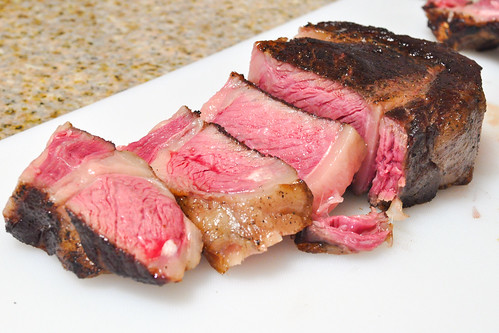Sous Vide Steak
Dining date: 4/13/13
While the most profound sous vide application may best represented in long-duration braises of the tougher cuts, breaking down connective tissues while keeping meat a medium-rare temperature, its applications for “simpler” cooking can be just as rewarding. For example, a steak can be prepared very well either on the stove top or seared and finished In the oven/broiler, but I often like to prepare one sous vide. There are a few reasons why.
One, like all sous vide cooking, it ensures precision in cooking temperatures. Even with a thermometer I still sometimes mess up and overcook a steak, something I consider a big no-no. Steaks can be some of the most expensive meats at the market, so I consider the extra time a worthwhile investment to get it just right.
Another is that I think it keeps a steak juicier. I don’t know the exact science behind it, but cooking at a lower temperature minimizes moisture loss in the muscle fibers; when cooking steaks sous vide, there’s rarely more than a couple of tablespoons of juice left in the bags after cooking.
My latest venture into sous vide steak utilized a 40-day dry aged Angus rib-eye from one if my favorite butchers in the city – McCall’s Meat & Fish Co. They’ve always got top-notch proteins and just started serving some great baked goods too (wife McCall was a pastry chef at Daniel in NYC and Sona in LA). The dry aged steak is one of the primo cuts of meat they have on a daily basis; they cut a piece almost two inches thick on the spot for me…resulting in a two-pound slab of beautiful meat.
As with any good piece of meat, not much needs to be added when cooking. I seasoned generously with salt, pepper, and garlic powder and sealed this bad boy up. Fresh herbs are optional.
I placed the steak in a 130F water bath for 5 hours. My sous vide timetables indicated it would take approx. 3.5 hours to come to temperature, but I let it sit in there a little longer for good measure.
Once ready, the steak just needed to be dried and seared. The residual juices in the bag (of which there were only a 2-3 tablespoons) could be served with the steak, used in a sauce (briefly microwave then filter to remove coagulated proteins), or just discarded.
I’ve found that searing in a cast iron pan (as hot as possible) with oil gives me the best crusty sear. Torching only just doesn’t get the desired crust, but I do often use it to supplement the cast iron pan.
It’s done! The steak was so juicy, glistening as I sliced into it – a good rib-eye is of course going to be pretty juicy, but I think it was enhanced by the low-temperature cooking method. I sacrificed a very small amount of medium-rare meat to ensure a great crust, something I considered worthwhile given the thickness of the steak; the enhanced flavor and the texture of the seared edges really made a difference.
Cooking a steak sous vide does not make a world of difference from conventional methods (not like, say, sous vide beef short ribs), but there are definitely worthwhile benefits to doing so if time permits.








Have you ever tried pre searing? MC recommends it. Never tried it
You know what, I haven’t. From what I’ve read it doesn’t sound like it makes much of an impact, but if the folks at Modernist Cuisine say so, maybe it’s worth a shot.
How thick how the rib eye?
It was probably a good inch and a half.